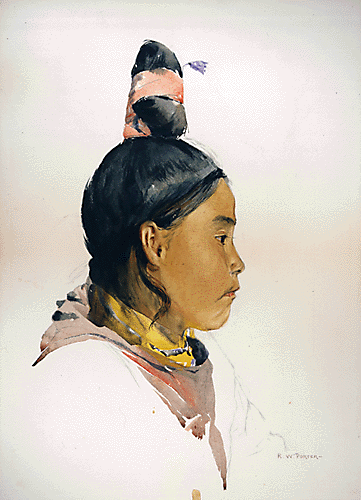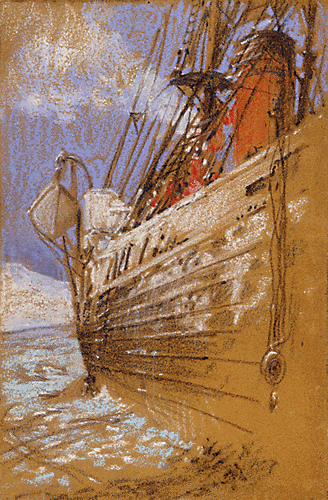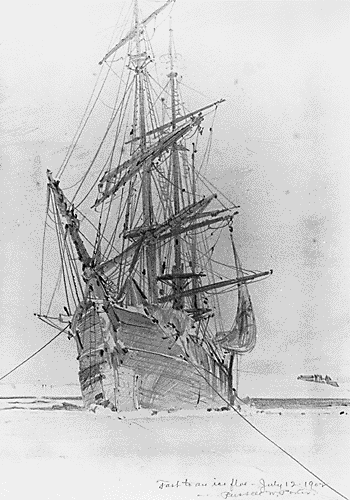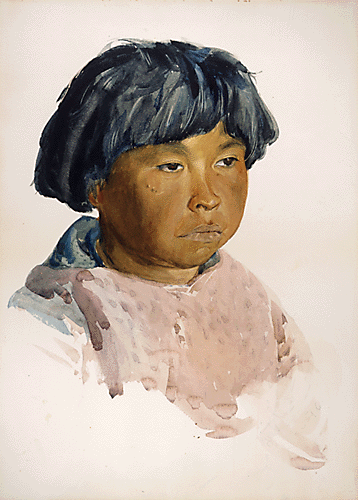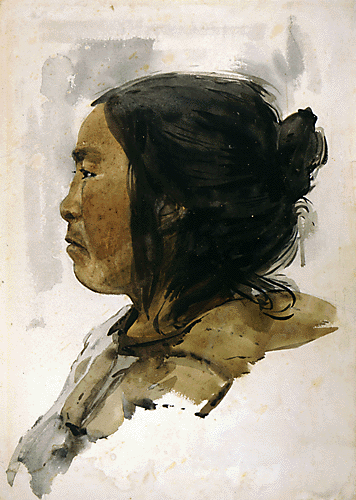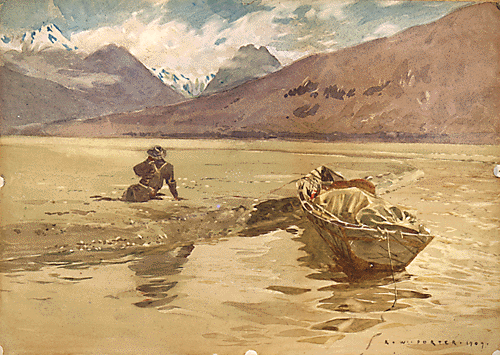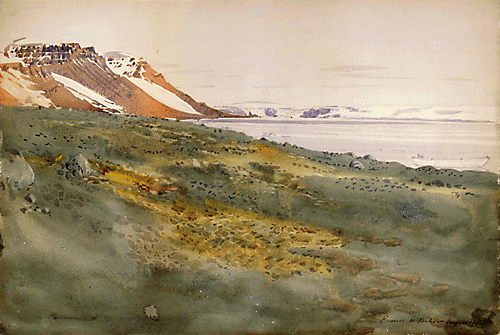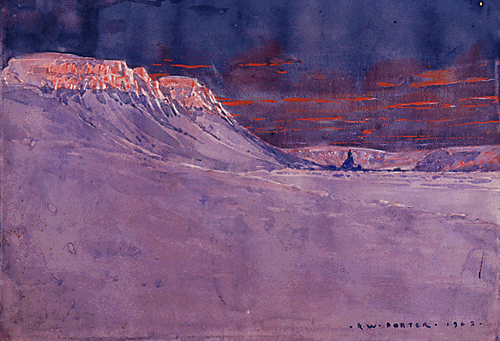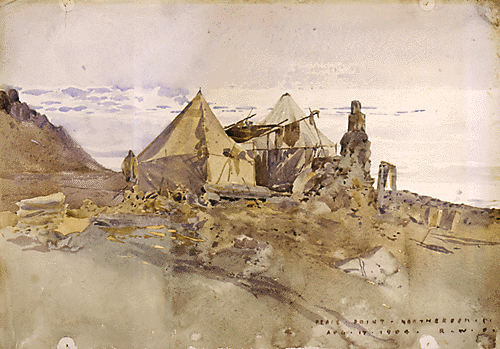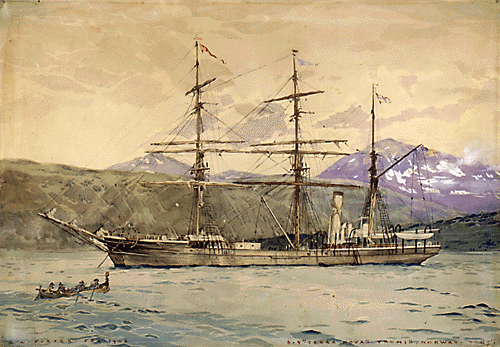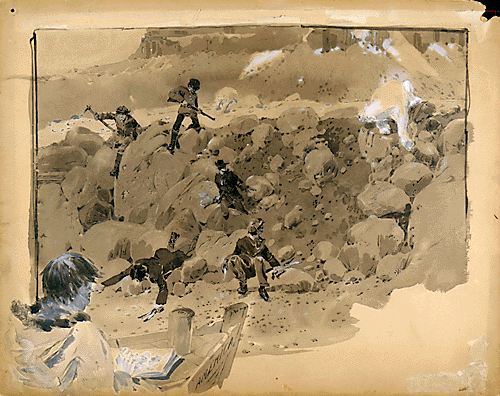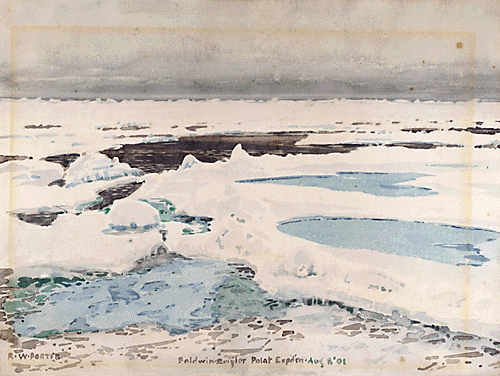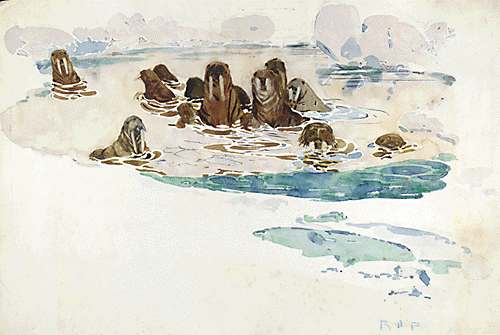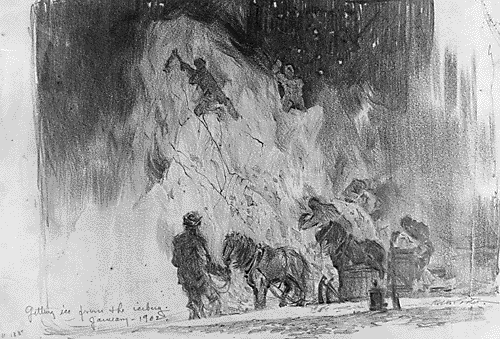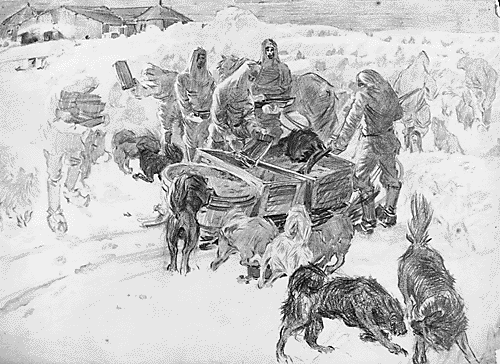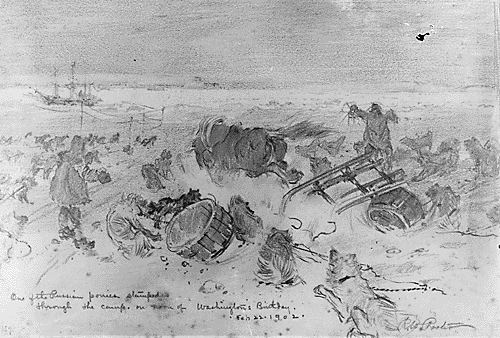
The Arctic Sketches of Russell W. Porter
Winter 1997, Vol. 29, No. 4
By Mary C. Ryan
One of the most exciting aspects of historical research is coming face to face with tangible evidence of past lives. Though sitting in a research room, one is transported to a different time and place, sharing the excitement, hardships, and hopes of journeys long past. Such an experience occurs in the study of the papers of Russell Williams Porter (1871–1949), one of several turn-of-the-century explorers who ventured into the alien regions above the Arctic Circle in a quest to reach the North Pole. Porter made the trip six times between 1894 and 1903 and left an impressive collection of paintings, drawings, notebooks, journals, and correspondence. One can appreciate Porter's sketches and paintings on many levels: as skillful and beautiful representations of the peoples and lands of the North; as documentation of episodes from the journeys; and, when one realizes that many of the sketches were drawn in subzero temperatures, as testament to the stamina of the expedition members. The Papers of Russell Williams Porter, 1893–1949, are found among the National Archives Collection of Donated Materials.
From 1968 to 1982, collections of federal records and private papers relating to U.S. activity in the polar regions were grouped in the Center for Polar Archives in the National Archives. Today the donated materials are preserved in the Archives II Textual Reference Branch in College Park, Maryland. Approximately 140 collections document Arctic and Antarctic explorations from the late nineteenth century through the 1960s. They contain correspondence, notebooks, diaries, scientific reports, photographs, newspaper clippings and other printed material, charts and maps, sound recordings, films, drawings, paintings, and artifacts.
Russell Porter's papers were donated to the National Archives and Records Service in 1974 by his daughter, Caroline Porter Kier. This portfolio features only a few of the sketches and watercolors in the collection. In addition to the many artworks, the Porter Papers contain diaries, correspondence, notebooks, photographs, and memorabilia. There is also a manuscript and typescript, with ninety-four pencil drawings, of his memoir, "Arctic Fever," which was published in 1976 under the title The Arctic Diary of Russell Williams Porter.
The title Porter gave his memoir aptly describes how intensely he felt the lure of the North. In his introduction he reflected, "there are plenty of fellows, perhaps to their sorrow, who well know the insidious disease, who enter the great white spaces year after year, only to return to civilization beaten and discouraged. . . . The call, in my own case, came suddenly, kept on calling for twelve years, and then as suddenly ceased. . . . My arctic goddess has given me many thrills, many heartbreaks, many crushing defeats, few favors."1
The sudden call came to him one evening in the fall of 1892. While an architecture student at the Massachusetts Institute of Technology (MIT), Porter attended a lecture by famed Arctic explorer Robert E. Peary and was captivated: "I could see nothing but the pictures Peary threw upon the screen."2 He immediately contacted Peary, but the explorer turned him down after receiving a letter from Mrs. Porter imploring him not to take her son to the Arctic. Porter soon got a second chance, though, in 1894. That summer he joined an excursion led by Frederick Cook to Greenland and crossed the Arctic Circle for the first time. Although the trip was cut short when the steamer Miranda had to be abandoned, Porter knew he would be back: "Those fugitive glimpses of the shimmering ice cap far back in the interior of that continental island, that week with the natives when the door to the North was barely opened before it was closed, the haunting melodies of the Eskimos accompanied by scuffing feet over a sand floor, the nights without darkness all served only to raise the fever to a higher pitch and a stronger determination to go farther and to see more."3
In 1896 Porter got the chance to see more when he joined Peary's expedition to Greenland. The party spent some time in Umanak, where Porter set up a studio and produced watercolor portraits of the Greenlanders. The next year he returned north with Peary to explore Baffin Island. In 1900 Porter was in Greenland again, this time to bring supplies to Peary, who was making another attempt at the Pole. For this trip, Porter had recruited six students who paid six hundred dollars apiece for the excursion aboard the Diana. He had made similar arrangements with students for the 1897 expedition (at five hundred dollars a head) and was thus able to pay off his entire college debt.
The last two attempts Porter made to reach the North Pole took a new route and were much longer journeys. With backing from wealthy businessman William Ziegler, Evelyn Briggs Baldwin was able to mount a major expedition. Russell Porter signed on to the Baldwin-Ziegler Polar Expedition of 1901 as artist and surveyor. Baldwin chose a different route north, starting in Franz Joseph Land, a group of islands north of Russia. The steam yacht America and two other ships carried the forty men, nearly five hundred dogs, fifteen Siberian ponies, and supplies. During this expedition, Porter once became so engrossed in his sketching that he did not notice a polar bear had come near. He tried to fire his gun, but the -35°F temperature had congealed the oil, and there was no response. As he moved away toward the camp, the bear came closer and sniffed the dropped sketchbook. After several more attempts, the gun finally went off, and Porter killed the bear and gained a story that he would retell many times.4 The Baldwin-Ziegler Expedition failed to reach the Pole, however, and returned home in summer 1902.
The next year, though, Ziegler backed another expedition, this time led by Anthony Fiala, who had been Baldwin's official photographer. Fiala asked the thirty-one-year-old Porter to come along as assistant scientist and artist. The America once more carried the explorers north in May 1903, but it did not return with them. In November the packed ice crushed the ship, leaving the Fiala-Ziegler Expedition alone in the frozen land for two winters, completely cut off from the rest of the world. They had no means of returning home, no radio, and no certainty of rescue. The sense of isolation, the months without sunlight, temperatures down to -62°F, food rationing, and inactivity led to short tempers at times. To combat boredom and raise morale, Porter made a couple of decks of cards for the men and contributed to the camp's newspaper, The Arctic Eagle. The men observed Christmas and New Year's with what feasts they could manage. Porter created illustrated menus and greeting cards for these events. His 1904 notes record: "Tomorrow is Christmas day. . . . All the souvenirs for Christmas and New Years are now ready. . . . After dinner I distributed Christmas greetings to each officer and member of the crew of the lost America."5 Despite these occasional diversions, Porter was happiest when on the trail with one companion or alone in his observatory.
His readings from the observatory helped determine longitude and were therefore critical to any success the expedition might have of reaching the Pole. Porter worked for two hours or more at a time in the cold without gloves or mittens because of the need to manipulate the delicate instruments. Temperatures reached thirty degrees below zero and lower, and at times he could not even hold a pencil. Even so, this Arctic work led him to his later career in optics: "I think this understanding of how the celestial mechanism behaves . . . was the cause that whetted my curiosity to know more about these instruments of precision."6
As the official artist on his last two polar expeditions, Porter produced an impressive number of sketches and watercolors. Most of the illustrations reproduced here depict scenes from the Baldwin-Ziegler Expedition. The Arctic setting presented unique challenges for an artist. His watercolors froze; snowblindness from the intense summer glare was a real danger; and the low light during winter made painting impossible. Pastels were often the only medium possible when the temperature was thirty to fifty degrees below zero. Frostbite was an ever-present danger: "I have worked away with one bare hand until the danger signal . . . told me in no uncertain way that it was time to stop and force back the circulation."7 Even with all these physical hardships, Porter declared that the hardest thing for him to bear was watching the Aurora during the dark winter months, "knowing I was absolutely helpless and unable to paint it."8 He tried to work by candlelight, but the yellow light distorted all the colors, and he decided it was better to put off any color work rather than use artificial light.
Although Porter could not always capture the northern colors in drawing, his notebook is full of color notes that describe the Arctic skies through the spectrum of his paintbox. He details the colors he saw, how they blended and shifted, and the quality of the light. In a word sketch of an early spring sky he instructs: "Starting with a deep orange at the horizon and blending perfectly with each other came Cadmium, chrome yellow, and then a beautiful, delicate pale green. Following this color came cobalt blue, intensifying to a veritable Prussian blue, so dark the stars could be seen twinkling against it."9
The alien light and climactic conditions were not the only obstacles the artist had to overcome. In an unpublished essay on "Sketching under Difficulties or The Trials of an Arctic Artist," Porter wrote of life on the trail: "After a day's travel . . . you stop and erect a thin silk tent, heat some pemmican and coffee; roll out the bag, enter it and try to sleep. Your bed is the snow itself. An hour or so of shivering is endured, the bag slowly thaws out, then drowsiness steals over you and blessed unconsciousness."10 During one excursion, with temperature twenty degrees below zero, Porter fell into water up to his waist. He raced back to camp and stripped off his clothes. While he curled up in his sleeping bag, his companion hung up the wet clothes to freeze. When the clothes had frozen, he then pounded the ice out of them.
In July 1905 the Terra Nova arrived and brought the Fiala-Ziegler party back to Norway. The expedition had failed to find a route to the Pole, but it had recorded much valuable scientific data. This was Porter's last trip above the Arctic Circle, though he did join Cook in a 1906 attempt to scale Mount McKinley in Alaska. A year after that excursion, he wrote in his diary: "I am getting old. That old desire of the north has claimed me year after year[,] taken the best out of my life[,] and left me little and much. Ten years has been required out of my life to satiate that lust of the polar world. What I prize now of worldly things are very simple."11
Settling in Port Clyde, Maine, Porter married Alice Marshall on November 27, 1907. Their daughter, Caroline, was born in 1912. He taught architecture for three years at MIT and during World War I worked for the National Bureau of Standards producing prisms and experimenting with the silvering of mirrors. What had begun as a hobby became his profession when he moved from building small telescopes to working on the two-hundred-inch telescope on Mount Palomar, California. He moved to Pasadena in December 1928 to take up his duties as associate in optics and instrument design. His technical drawings and cutaway views of the telescope were highly regarded not only for their precision but also for their beauty. He returned briefly to government work during the Second World War making cutaway drawings of weapons systems for the U.S. Navy.
This portfolio of Russell Williams Porter's artwork concentrates on his polar expeditions, but his reputation was made primarily in the fields of optics and astronomy. In addition to his work on the massive Palomar project, he enthusiastically encouraged and helped amateur telescope makers. In 1970 the International Astronomical Union approved the renaming of moon crater Clavius B after Porter.12 He received an honorary doctor of science degree from Norwich University in 1946 and on the eve of his death had been notified that Middlebury College planned to bestow the same honor. In his seventy-seven years, Russell Porter was rarely idle. On the very day he died, February 22, 1949, he had been working in his basement on a lens system.13
Porter was satisfied that he had lived an active and productive life. Many years after his northern voyages, from his southern California home, he concluded his memoir with these words:
And so these last lines are being penned under sunny skies. I often recall that pledge made when [Duncan] Butland and I were dragging our sleeping bags through the snow frozen feet and fingers fighting for our very lives: "If I ever get out of this, I'm going to the Equator and stay there." And his reply: "Me for New York." Well, I am not on the Equator but considerably nearer to it than the Pole, in fact nearer to it than the rigors of a New England winter. I have no ax to grind with my northern sweetheart now. All things come to those who wait.14
Notes
1. The Arctic Diary of Russell Williams Porter, ed. Herman Friis (1976), p. 3.
2. Ibid., p. 4.
3. Ibid., p. 19.
4. Ibid., p. 90.
5. "The Arctic Diary of Russell W. Porter," pp. 73, 74, box 6, entry 4, Papers of Russell Williams Porter, 1893–1949 (XRWP) (formerly RG 401 [27]), National Archives Collection of Donated Materials, National Archives and Records Administration (hereinafter cited as Porter Papers, XRWP, NARA).
6. Arctic Diary of Russell Williams Porter, p. 164.
7. Russell W. Porter, "Sketching under Difficulties or The Trials of an Arctic Artist," box 1, entry 2, Porter Papers, XRWP, NARA.
8. Ibid.
9. Porter, "The Brilliant Coloring of the North," box 1, entry 2, Porter Papers, XRWP, NARA.
10. Porter, "Sketching under Difficulties," box 1, entry 2, Porter Papers, XRWP, NARA.
11. Diary entry for Mar. 16, 1907, Diary and Journal Notes, box 1, entry 2, Porter Papers, XRWP, NARA.
12. Berton C. Willard, Russell W. Porter: Arctic Explorer, Artist, Telescope Maker (1976), p. 241.
13. Ibid., p. 261.
14. Arctic Diary of Russell Williams Porter, pp. 168–169.
